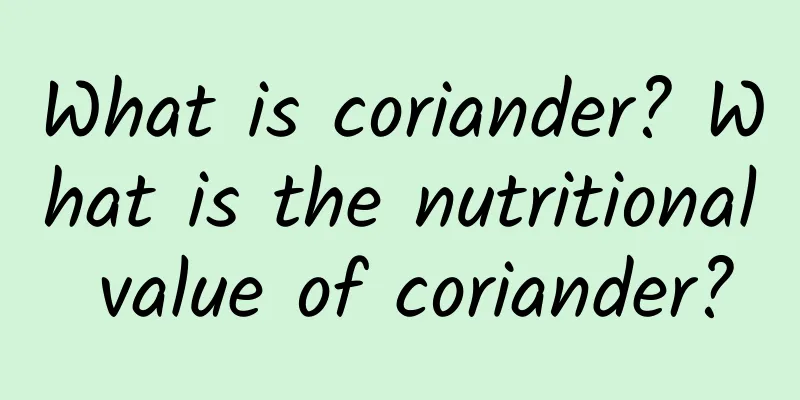What is coriander? What is the nutritional value of coriander?

|
Coriander is an important spice vegetable, refreshing and appetizing, and can be added to soup. The stems and leaves are used as vegetables and spices, and have the effect of strengthening the stomach and digestion; the stems are cylindrical, upright, multi-branched, striped, and usually smooth. The amount of vitamin C contained in coriander is much higher than that of ordinary vegetables. Coriander has a strong taste. People who like to eat it like it very much, and those who don't like it will not even smell it. Which category are you in? Contents of this article 1. What is coriander? 2. What is the nutritional value of coriander? 3. How to eat coriander 1What is coriander?Coriander, formerly known as coriander, alias: coriander, coriander, Latin name: Coriandrum sativum L. It is an annual or biennial herb with a strong smell, belonging to the Apiaceae family and the genus Coriander, 20-100 cm high. The root is fusiform, slender, with many slender lateral roots. The stem is cylindrical, erect, multi-branched, striped, and usually smooth. The basal leaves are petiolate, the style is erect when young, and recurves outward when the fruit is ripe. The fruit is spherical, with obvious main ridges and adjacent secondary ridges on the back. The ventral surface of the endosperm is concave. The oil tube is not obvious, or there is one located below the secondary ridge. It is native to the Mediterranean region of Europe and is cultivated in Northeast my country, Hebei, Shandong, Anhui, Jiangsu, Zhejiang, Jiangxi, Hunan, Guangdong, Guangxi, Shaanxi, Sichuan, Guizhou, Yunnan, Tibet and other provinces and regions. The stems and leaves are used as vegetables and spices, and have the effect of strengthening the stomach and helping food; the fruits can be used to extract aromatic oils; the fruits are used as medicine, and have the effects of dispelling wind, clearing rashes, strengthening the stomach, and removing phlegm. 2What is the nutritional value of coriander?1. The tender stems of coriander contain volatile oils such as mannitol. 2. The carotene content in coriander is more than 10 times higher than that in tomatoes, green beans, cucumbers, etc. 3. The amount of vitamin C contained in coriander is much higher than that in ordinary vegetables. Generally, 7 to 10 grams of coriander leaves can meet the body's demand for vitamin C. 4. Coriander is rich in nutrients and has a high water content of up to 90%. Coriander contains vitamin C, carotene, vitamin B1, B2, etc. It also contains rich minerals such as calcium, iron, phosphorus, magnesium, etc. Coriander also contains potassium malate, etc. 3How to eat coriander1. Coriander is an important spice vegetable, refreshing and appetizing, and can be added to soup. In addition, coriander contains essential oils and has a strong pungent taste. Do not make juice alone for drinking. You can mix it with other fruits to make juice for drinking, but do not exceed 30 grams each time. 2. Do not eat rotten or yellowed coriander, because it has lost its aroma and has no effect as mentioned above. It may also produce toxins, which may cause nervous organ disorders. |
<<: Avoid the sun, work hard to live... Post-80s people living under the shadow of hepatitis B
>>: Oh my god, I was burned by a 40℃ hand warmer...
Recommend
Will the discharge continue if the membranes rupture prematurely?
There are many reasons for placental abruption. M...
Does brown vaginal discharge mean the abortion is not complete?
Choosing medical abortion is more convenient in o...
How to increase breast milk when breast milk is decreasing
For babies during breastfeeding, mother's mil...
StatCounter: In Q2 2014, Apple devices accounted for 51.6% of mobile traffic, ranking first
199IT original compilation Apple's release of...
"Cure" or "cause cancer"? The health truth behind the aspartame controversy
According to Reuters, the artificial sweetener as...
What will happen if you eat pomegranates during pregnancy? What are the precautions for eating pomegranates during pregnancy?
We all know that pomegranate is a popular fruit. ...
How many days does it take for cervical cancer screening results to come out?
Women who suspect they have cervical cancer can u...
When is the rainy season? What to eat during the rainy season? Recipes for dehumidifying soups during the rainy season
Excessive fatigue can easily lead to the invasion...
Is it normal to have no fetal movement for a day or two?
The fetal movement will be reflected immediately ...
How big is the gestational sac at five weeks of pregnancy?
Generally, sperm and egg need to combine to form ...
Is sweet potato a sweet potato? How to bake sweet potato in the oven
We often see a lot of baked sweet potatoes and ho...
How to heat pizza in the microwave to make it taste better? How to heat frozen pizza in the microwave?
For many friends who love pizza, they often like ...
Female ovary navel location map
The uterus and ovaries are indispensable structur...
Dietary Guidelines for Lactating Women
For women, it is necessary to supplement nutritio...
What are the risks of miscarriage at six months?
Abortion is mainly divided into two types: artifi...









